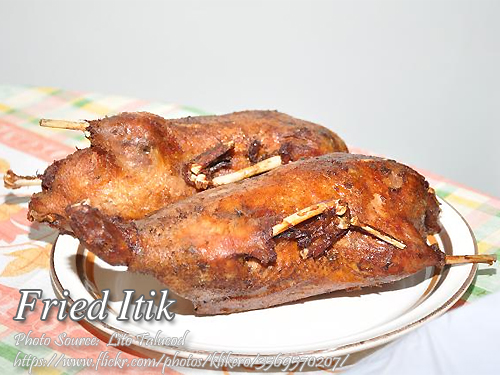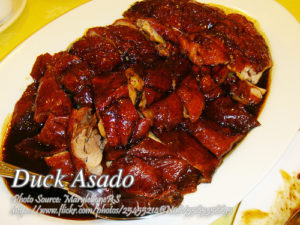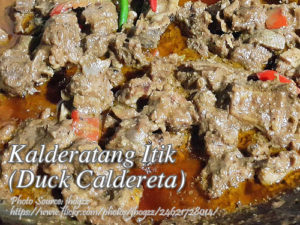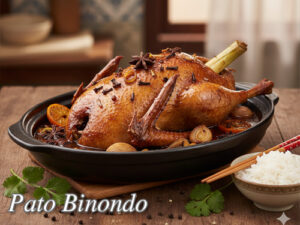Fried itik or fried native duck is one of the popular dishes or fried food sold by sidewalk vendors. Although this is more expensive compared to roasted or fried chicken, you can never replace the taste of fried itik. One place where you can find many vendors of this fried duck is in Angono, Rizal. But not all of them have the same quality and taste. Some are not properly prepared to remove the gamy flavor and smell.
Some are not as tender and juicy as the others. Of all the vendors iin that place, there is one place you can never go wrong, that is in Marlon Special Fried itik in Angono, Rizal. I once asked the vendors where did they get the raw ducks. Did you know that those native ducks that are cooked in this town comes from Pampangga? They say it is cheaper to buy it from there than to raised them locally. There are also vendors of fried itik in Pampangga but the tastiest are those from Angono. But you know, it will be even more tastier if you will cook it yourself by trying the recipe below.
Fried Itik: A Flavorful Nostalgic Delight
This fried native duck is a beloved dish in many Filipino towns, and it’s one that holds a special place in my heart. I remember the first time I tasted itik from the roadside stalls in Angono, Rizal, where it’s a true local specialty. There’s something about the crisp, golden skin, the juicy meat, and the way the flavors just burst with every bite. Compared to the more common fried chicken, it carries a unique depth that is hard to replicate. It’s a dish that my uncle, Tito Danny, would always rave about after his trips to Angono. He would say, “Once you’ve had fried itik, no other fried dish will compare.”
Although it’s more expensive than your regular fried chicken, the flavor of itik is well worth the cost. But here’s a little secret: cooking at home can be even better than buying from the vendors. It’s a recipe that has been passed down in our family, and I learned some tips and tricks from my cousin, Ate Lani, who swears by a few techniques to really bring out the best in the dish.
The Charm of Angono’s Fried Itik
If you ever find yourself wandering the streets of Angono, Rizal, you’ll notice countless vendors offering their own version. Each stall has its own twist, but none are quite as popular as Marlon Special Fried Itik. Every time I visit, I make sure to stop by Marlon’s stall to grab a piece or two. I remember asking the vendor once about where they get their ducks. Turns out, most of the ducks come from Pampanga, a province famous for its culinary traditions. My lola always said Pampanga was the “food capital of the Philippines,” and this explains why their ducks are so highly prized.
Still, no matter how good the ducks from Pampanga are, the secret lies in how you prepare them. Not all fried native duck is created equal, and some stalls in Angono may leave you with an unpleasant gamy taste if they don’t know how to clean and season the duck properly. That’s why learning to cook it at home gives you control over every step—ensuring that each bite is tender, juicy, and free from that strong gamy flavor that can turn people away from duck.
Preparing the Itik: Key Techniques
The first and most important step when cooking it is cleaning the duck thoroughly. Native ducks tend to have a stronger, gamier flavor compared to farm-raised chickens, and if not cleaned well, this can affect the overall taste of the dish. My mom, Nanay Lily, always taught me to scrub the duck with salt and rinse it well before cooking. This technique helps remove the natural oils that contribute to the gamy flavor. She would also soak the duck in a mixture of vinegar and water, which she said helps reduce any unpleasant odor.
Simmering the duck in water, salt, ginger, and celery for about an hour and a half is the next crucial step. This method, which I learned from my cousin Lani, not only tenderizes the meat but also infuses it with subtle flavors. Ginger, in particular, is a common ingredient in Filipino cooking when dealing with strong-flavored meats like duck or goat. It helps mellow the taste while adding a mild, refreshing note to the dish. Celery, on the other hand, brings in a fresh aroma that complements the richness of the meat.
After simmering, it’s essential to let the duck dry thoroughly. My brother, Kuya Jun, who once worked at a carinderia, says this is one step many people overlook, but it makes all the difference when frying. Drying the duck helps achieve that perfect golden-brown crispiness when it hits the hot oil. I usually pat it dry with paper towels and leave it to rest for a few minutes before deep frying.
The Joy of Frying Itik at Home
Deep frying is where the magic happens. Once the duck is simmered to tender perfection and dried, you’ll want to fry it in hot oil until it reaches that beautiful golden-brown color. The trick here is to use a lot of oil—enough to submerge the duck completely. I remember my Tito Danny saying, “Don’t be shy with the oil. The more, the better for a crispy finish.”
There’s something incredibly satisfying about hearing the sizzle of the duck as it fries. The skin becomes wonderfully crispy, while the meat remains tender and juicy, thanks to the slow simmering process. When I make this dish at home, the aroma fills the entire kitchen, and it brings back memories of family gatherings where it was always the star of the show.
A Perfect Sauce to Pair
The sauce for this fried duck is simple but a perfect complement to the rich flavors of the duck. It’s made by simmering soy sauce, vinegar, sugar, and some spices together until it thickens into a savory, slightly sweet glaze. In Pampanga, they sometimes add calamansi juice for a hint of citrusy brightness. This sauce is essential—it adds depth and brings out the natural flavors of the duck, balancing the richness with a bit of tang and sweetness.
A Taste of Nostalgia
Fried itik isn’t just a meal; it’s a slice of Filipino culinary heritage. The dish dates back to simpler times, when native ducks were more commonly raised and cooked at home. While today we often associate it with street food vendors, the tradition of preparing it at home is still alive. I’ve seen my relatives, especially during family reunions, take pride in making it, sharing stories of their travels to Pampanga and Angono, where the dish is celebrated.
So next time you crave something a little more special than fried chicken, why not try making fried itik yourself? You’ll not only enjoy a delicious meal but also carry on a tradition that’s been passed down through generations.
How to Cook Fried Itik
Ingredients
- 1 piece regular-sized native duck (itik)
- 2 1/4 cups water
- 2 Tbsp. rock salt
- 1 thumb-size ginger sliced
- 1 stalk celery sliced 1 inch-size
- 2 cup cooking oil
Sweet Chili Sauce
- 1/2 tsp. cornstarch
- 1/4 cup water
- 3 Tbsp. vinegar
- 1 Tbsp. sugar
- 2 pcs hot chili pepper
- 1 tsp. salt
Instructions
How to Cook Fried Itik:
- Clean duck very well.
- Simmer duck in water, salt, ginger and celery stalk for about 1 and 1/2 hours or until tender.
- Drain and dry in paper towel.
- Deep fry in hot oil until golden brown. Serve hot with sauce.
To Make The Sauce:
- Combine all sauce ingredients in a sauce pan.
- Simmer while stirring continuously, until sauce thickens. Serves 6.
Notes
Cooking Tips:
Clean the Duck Thoroughly
To remove the gamy flavor, it's essential to clean the duck properly. Rub it with salt and rinse well to eliminate natural oils that cause an unpleasant odor. Soaking the duck in a vinegar-water mixture before cooking helps neutralize any strong smells.Simmer for Tender Meat
Simmering the duck with ginger, salt, and celery for about 1 to 1.5 hours ensures the meat becomes tender and absorbs subtle flavors. Ginger helps mellow out the strong taste of the duck, while celery adds a fresh aroma. This step is key to achieving juicy meat once fried.Dry the Duck Before Frying
After simmering, make sure to pat the duck dry with paper towels. Removing excess moisture allows the skin to crisp up nicely when deep-fried. This ensures a golden-brown, crispy texture without sogginess.





